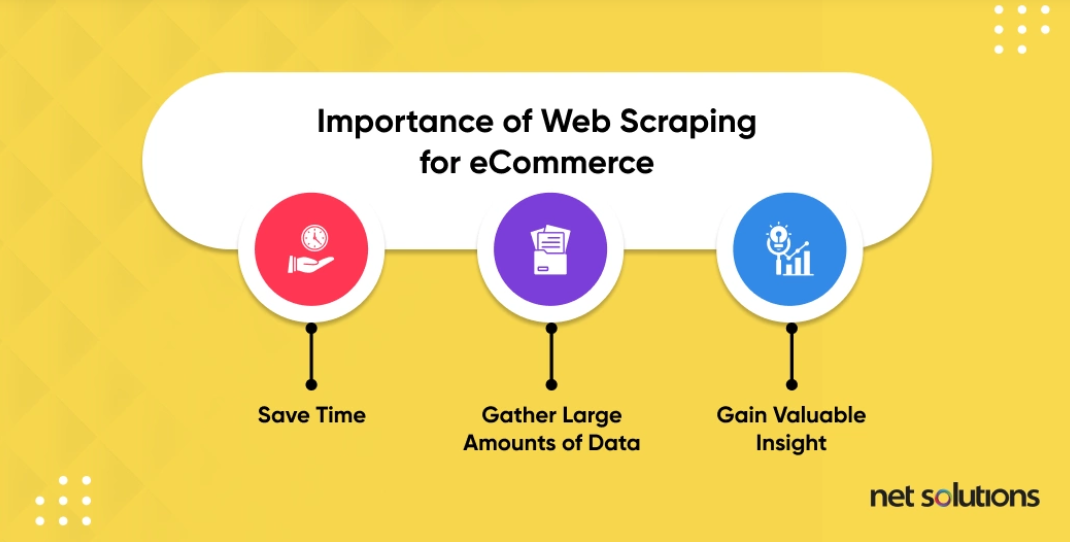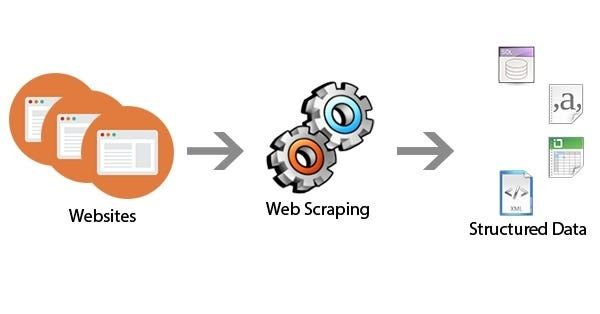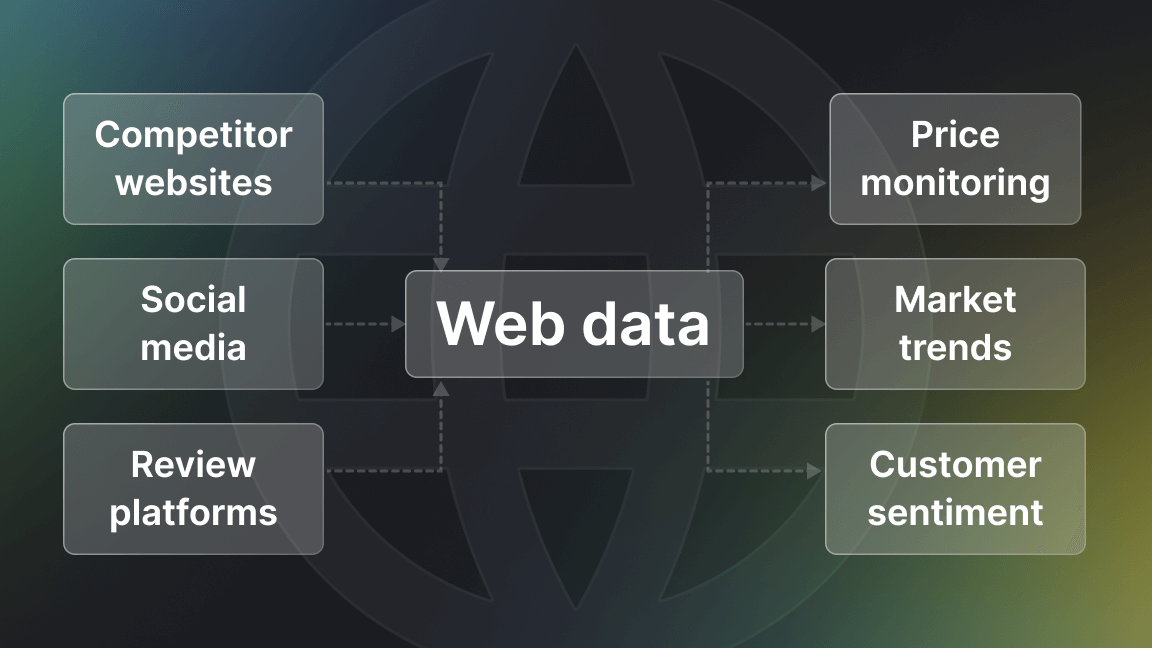90% of consumers read online reviews before purchasing in 2023. Reviews are the new word-of-mouth, influencing decisions all over the globe. But how do businesses gather these myriad reviews from sites as vast as Amazon or even social media platforms like Instagram? That’s what this article introduces: product review scraping.
In this guide, we'll peel back the curtain on the best and most efficient methods for review scraping. We'll dissect methods tailored for scraping Amazon and dive into the unique challenges Instagram poses so you're adept at sourcing reviews from both.
By the end, you won’t just master scraping the best reviews but be well-versed in turning them into strategic assets - from enhancing product features and refining marketing strategies to improving customer experience, you’ll be prepared. So, let’s begin.
What is product review scraping?

In simplest terms, product review scraping is the process of extracting or "scraping" reviews and feedback from various websites and online platforms.
Each website, be it Amazon, Yelp, TripAdvisor, or even smaller niche forums, hold countless 'books' brimming with customer reviews. Browsing through them manually? Quite the challenge and, frankly, inefficient.
Specialized tools such as Apify, Crawlee, Scrapy, and Beautiful Soup seamlessly facilitate this extraction process. The goal isn't just about mere data collection; it's about turning this raw data into actionable insights to:
- Tailor your messages
- Refine your product offers
- Elevate your customer service
- Anticipate upcoming market shifts
This technique has empowered businesses big and small to be in tune with their customers' needs, praises, and critiques. Review scraping is no longer a luxury but a necessity. In an era where the consumer's voice is louder and more influential than ever, tapping into that voice and understanding it is the first step to improving your overall brand’s engagement.
So how can you strategically scrape the best reviews? Consider the steps in the next section.
7 steps to scrape product reviews from e-commerce websites

As businesses grow, the sheer feedback can become overwhelming, and time, as they say, is money. Consider how you can scrape your product reviews in these 7 simple steps so that you no longer miss out on valuable feedback and resources.
1. Understand your needs
Start by clearly defining what you want to achieve with this data. Are you looking to improve a product feature? Launch a new line? Or maybe just trying to understand the current market trend about your brand? These answers will direct your research. So when creating your product roadmap, prioritize initiatives that align closely with these strategic objectives to maximize impact and relevance in the market.
For instance, if you're researching toys, a general sweep might get you an overview of trends. You'll come across parents raving about a toy's educational benefits on sites like Amazon.
However, if your primary concern is safety or durability, then this broad approach will miss the mark. Instead, you'd need to zero in on specific feedback forums or safety watchdog websites that focus on these aspects.
Taking baseball as an example, a simple glove might not warrant the same insight as a pitching net would. Specialized platforms or dedicated sports forums provide insights that are more concentrated and, thus, more valuable.
Here, athletes, coaches, or enthusiasts will discuss the nuances – the weight, grip, durability, or even aerodynamics. These insights go beyond what the general public might offer. Ultimately, understanding your needs is about efficiency and precision. It's about ensuring that every data piece you collect resonates with your objectives, serving a purpose.
2. Choose the right e-commerce platform
The e-commerce world is vast and varied. Much like how every shop on a bustling city street offers a different ambiance and product range, each eCommerce platform brings its own reviews and user experiences. A B2B marketplace will differ significantly from B2C platforms in terms of functionalities, review systems, and user demographics, reflecting the unique needs of business buyers versus individual consumers. Deciphering which platform aligns best with your objectives is key to an efficient review-scraping mission.
For example, giants like Amazon have numerous reviews because they sell so many products to a large user base. Here, you'll find both negative reviews and positive feedback ranging from one-liners to detailed feedback, all in the form of user-generated content. With bigger sites, you get feedback, but the specific details might get lost.
On the other hand, platforms dedicated to star ratings might have fewer reviews than Amazon but can give an immediate visual insight into customer satisfaction.
For instance, if you're exploring travel deals, a site dedicated to helping travelers find cheap tickets might provide richer, more detailed reviews about user experiences, ticketing processes, and hidden deals. These platforms are gold mines for those seeking comprehensive insights into specific products or services.
These platforms can be a treasure trove for someone looking for detailed user experiences.
Still unsure where to begin? You can find comprehensive lists detailing the best product review sites that cater to various niches and needs. These guides can offer a starting point, steering you towards platforms most aligned with your objectives.
3. Familiarize yourself with the website structure
Given that reviews often come in a structured format, understanding a website’s blueprint can simplify your scraping efforts. Sometimes, reviews are nested, other times, they span multiple pages.
Modern websites also employ dynamic content-loading techniques. This means that as a user scrolls or interacts with the page, new content (including reviews) can appear. Remember to be aware as traditional scraping methods might overlook these dynamically loaded reviews.
Moreover, there are instances where user actions – like clicking a 'load more' button or selecting a particular product variant – trigger additional reviews. These nuances in a website's interactive design can heavily influence how you set up your scraping tools.
4. Choose between manual vs. automated data collection

Copying data by hand? It's time-consuming, tiring, and there's a lot that can go wrong. Automated tools, especially those utilizing natural language processing and real-time data pipelines, can easily discern and categorize feedback, offering insights beyond mere text.
For a few reviews, doing it manually is fine. But for several? Automation is way better. Here's a clearer look:
| Method | Pros | Cons |
|---|---|---|
| Manual collection |
- Perfect for small jobs. - You get to feel the vibe of each review. |
- Takes time for big sites. - More room for mistakes. |
| Automated collection |
- Can handle data loads without breaking a sweat. - Consistent and precise. - Can keep fetching new reviews regularly. |
- There's a learning curve. - Need to know how to set it up. |
5. Select the ideal scraping tool
Choosing a tool is more than just picking the most popular. In your marketing efforts, make sure that the tool can also understand semantics or the sentiment behind online reviews.
Here's a run-down to help you make an informed choice:
- Scalability: Consider your long-term vision. A solo blogger might not need the firepower that a multinational company requires. But as you grow, you won't want to change tools every other month. A scalable tool adjusts to both small and massive projects, offering a smooth transition.
- Dynamic content handling: Websites today aren’t the static pages they once were. They're lively, interactive, and often updated without a full page reload. Can your tool cope with AJAX loads or infinite scrolling? This ability is non-negotiable for modern web scraping.
- Learning curve: A complex tool with no guidance is like being handed a jet plane's controls with no manual. Look for user-friendly interfaces, accessible tutorials, and active community support.
- Robustness and reliability: A good tool won't buckle under pressure. It should handle potential roadblocks, such as CAPTCHAs, IP bans, and redirects, without breaking a sweat.
6. Practice ethical scraping
Websites take work to create. Overloading them with requests is not just unethical but can also get you blacklisted. Another thing to note is the search query rate; excessive search queries can flag your actions as spam. Here’s a friendly guide to scraping without stepping on toes:
- Web etiquette: Behind every website, there's a team (or at least one person) who's poured time and effort into it. Heavy scraping can slow down their servers or even crash them, impacting their operations and users. Always consider the digital space you're entering.
- Frequency matters: Bombarding a website with back-to-back requests? Not cool. Space out your requests. Most scraping tools allow you to set intervals between requests to avoid overwhelming the target site.
- Proxy servers: These are your best friends in the scrapping world. They distribute your scraping requests across different IP addresses. It’s like spreading out your footprints, making sure you don’t leave a deep impression in one spot. Plus, it reduces the risk of getting banned.
- Respect "robots.txt": It's a file most websites have that lays out the ground rules for scraping. It tells you which parts are okay to access and which aren’t. Before scraping, make sure to take a quick peek.
7. Get your data in order
Jumbled reviews help no one. After you've gathered all those reviews, it's tempting to dive right in. But hold on a second. Raw data is like mixed-up puzzle pieces. Sure, all the pieces are there, but it's hard to see the big picture.
Start by sorting your data. Use databases or spreadsheets to lay everything out clearly. Consider seeking help from a professional like an executive assistant who is already good at organizing tasks and schedules.
With their skills, your reviews could be sorted by product, rating, or keywords in no time, making your life a whole lot easier. Maybe you want to group reviews by product type or rating. Or perhaps you're looking for common keywords or phrases people use.
Once everything's organized, it becomes way easier to spot trends, run analyses, or share insights with your team. Plus, when someone asks, "Hey, what are customers saying about our new product?" you'll know exactly where to look.
6 steps to scrape product reviews from social media networks

Social media is packed with what people think about brands. So, how can you collect this feedback in an organized way?
1. Determine your target keyword
Start your journey with a solid footing by thoroughly understanding how people talk about your brand. Remember, it's not always "@BrandName" mentions. Often, it's the casual chat about a product feature or a shoutout to a new advertisement that provides the most valuable insights. Think of all the possible variations: product names, slogans, or even common misspellings.
Stay updated with trending hashtags and slang that might be associated with your products. This step will ensure you're not missing out on any conversation that matters.
2. Pick the right social media platforms
Each social media channel is like a different neighborhood in the internet world. You have to know which parts your audience loves hanging out in.
Take e-commerce reviews: they're organized, tidy, and in one place. Social media? Not so much. Brand mentions can be tucked into a fleeting Instagram story, buried in Twitter threads, captured in TikTok reels, discussed in Facebook comments, or even debated passionately in niche private groups. It's a dynamic landscape out there.
For instance, on Pinterest, you might stumble across boards dedicated to sustainable living, showcasing everything from eco-friendly home designs to comprehensive solar power system collections.
Some pins go all out, teaching you how to kickstart your green energy journey, including a few that link you straight to different solar power system setups, showing off different models and configurations. These platforms become essential places for enthusiasts to exchange ideas, recommend products, and learn from one another.
If you're launching a cutting-edge video game, you're more likely to find your gamers debating game physics on platforms like Reddit or coordinating multiplayer matches on Discord than seeing them discuss it over LinkedIn.
It's also about the depth and engagement type. A beauty product might enjoy aesthetically pleasing reviews on Instagram but find in-depth usage techniques on YouTube. In the same way, consider fashion. For instance, a chic lingerie collection might be showcased through polished editorial shots on a website but receive real-world reviews and styling tips on social platforms.
So you should think about your audience's demographic, habits, and preferences. It's about aligning with their language, understanding their platform choice, and ensuring that they're present in those digital spaces, actively listening and engaging.
3. Equip yourself with real-time monitoring tools
The digital world never sleeps. On social media, content keeps flowing, stories keep updating, and tweets keep coming. You don't want to miss out on a golden review or important feedback just because it got buried under newer content.
Tools like Hootsuite, Mention, and Brand24 give you the superpower to keep up with this rapid pace. They continuously scan and capture relevant mentions, ensuring you always have the freshest insights at your fingertips. Think of them as your digital watchdogs, always on the lookout so you're never out of the loop.
4. Choose the right frequency for monitoring
Frequency matters. How often you choose to monitor can make a huge difference in capturing relevant content. While some brands might be content with a daily or weekly overview, others, especially those in fast-paced industries or launching new products, might want hourly updates.
If you're wondering how often to dive in, start by gauging the volume of mentions your brand typically receives.
Brands with high social media traction might need to adopt a more frequent monitoring schedule. At the same time, a local business with a quieter social media presence can likely opt for less frequent checks.
Remember, the goal isn't just to capture mentions but to engage promptly. Using effective customer feedback tools can help you monitor and respond to customer queries or acknowledge feedback swiftly, building brand goodwill. Thus, align your monitoring frequency with your engagement goals.
5. Dive deep with sentiment analysis
Now, it's not just about collecting all these mentions and feedback; it's about understanding them. Sentiment analysis is like having a superpower that allows you to gauge the mood behind every comment. Is the tone positive, negative, or neutral? This can be particularly vital when dealing with a large volume of feedback.
You can find tools that delve deep into analytic solutions like advanced sentiment analysis, categorizing feedback in a way that allows brands to address negative mentions or amplify positive ones swiftly. This in-depth understanding ensures that you're not just reacting to the surface content but grasping the emotions behind them.
6. Engage and interact
You've successfully scraped product reviews and feedback from social media. Now, what's the next step? Engage. Social media is a two-way street. It's not enough to just listen; you need to participate.
Whether it's a simple acknowledgment, addressing a concern, or even participating in light-hearted banter, your engagement can transform a mere mention into a meaningful conversation.
Beyond just social media, engagement can also be amplified through efficient tools. For instance, if you're utilizing platforms like Microsoft Outlook for email interactions, it would be beneficial to explore ways to get more from your Microsoft Outlook, ensuring that every touchpoint with your customers is optimized.
These interactions can solidify brand loyalty, address misconceptions, or even guide potential customers toward a purchase.
Building a strong presence isn't just about collecting data but creating authentic interactions based on it. So, keep the conversation going, be genuine in your responses, and cultivate a brand persona that resonates with your audience.
Product review scraping is a gamechanger
Product review scraping in 2023 is more than just a trend – it's an absolute gamechanger. By getting the lowdown on what people think about your products, you're unlocking invaluable insights that can steer your brand in the right direction.
Remember, it's about getting the real scoop from your customers and turning it into actionable insights. One golden nugget? Regularly update your scraping tools. The digital landscape changes fast, and you want to stay ahead of it.
Don't just gather reviews; make an effort to understand them. There's a world of difference between just hearing and genuinely listening.
Ready to dive into the world of web scraping without the headache? Check out hundreds of ready-to-use scrapers Apify Store. It's where savvy developers go to build and keep an eye on top-notch web scrapers. So why wait? Let's make the most of those reviews!
This is a guest post from Burkhard Berger, the founder of Novum™. He helps innovative B2B companies implement revenue-driven SEO strategies to scale their organic traffic to 1,000,000+ visitors per month. Curious about what your true traffic potential is?








